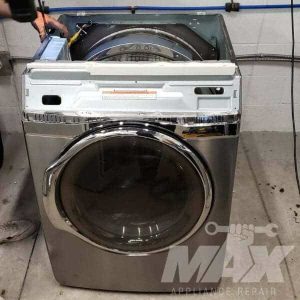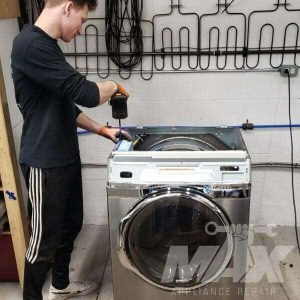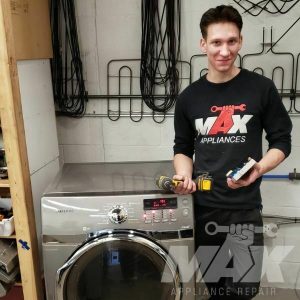
Fixing A 2021 Samsung Dryer With A Main Control Board Issue
At Max Appliance Repair, we take pride in providing top-notch repair services for all types of appliances. We recently took on the challenge of fixing a 2021 Samsung dryer that wasn’t turning on. Despite the advanced technology in this dryer, our team was up to the task. We quickly got to work diagnosing the issue and developing a solution to get this appliance back up and running in no time.
Through careful analysis and testing, we identified the root cause of the problem and used our expertise to make the necessary repairs. Our skilled technicians worked tirelessly to ensure that every component was functioning as it should be. Ultimately, we were proud to deliver a fully operational 2021 Samsung dryer back to its owner. At Max Appliance Repair, we take satisfaction in knowing that our customers can rely on us for even the most complex appliance repairs.
Our Samsung Dishwasher Repair in Pictures
Using our extensive range of replacement parts and experienced technicians, our technicians can diagnose any dryer issue promptly. Our dryer repair services are available for all models and make, from malfunctioning control boards to faulty control boards, heating pumps, etc. Whenever you need quality dryer repair service, do not hesitate to contact us or call us today at (647) 477-0946.
Some More Common Issues With Samsung Dryers
Samsung dryers are known for their advanced features and efficient performance. However, like any other electronic device, they can develop problems from time to time. Here are five common issues with Samsung dryers:
Overheating:
One of the most common issues with Samsung dryers is overheating. This can be caused by a clogged vent, a faulty thermostat, or a malfunctioning heating element. Overheating can damage the dryer and even cause a fire hazard, so it should be addressed promptly.
Noisy operation:
Another common issue with Samsung dryers is noise during operation. This can be caused by a loose belt, worn-out rollers, or a damaged drum. A loud dryer can be irritating and also indicates a potential problem that needs to be fixed.
Failure to start:
A third common issue with Samsung dryers is failure to start. This can be caused by a faulty start switch, a broken door switch, or a blown thermal fuse. It can be frustrating when the dryer won’t start, and a professional should be contacted to diagnose and repair the issue.
Clothes not drying:
A fourth issue with Samsung dryers are clothes not drying properly. This can be caused by a clogged vent, a damaged heating element, or a malfunctioning thermostat. If clothes are still damp after a full cycle, the issue should be addressed to prevent damage to the dryer and clothes.
Error codes:
Lastly, Samsung dryers may display error codes that indicate a problem. These can include issues with sensors, wiring, or other components. Error codes should be checked against the manual or with a professional to determine the cause and fix the issue.
Licensed & Experienced
Warranty on Parts & Labour
100% Customer Satisfaction
Award Winning Support
24/7 Emergency Services
Common Error Codes For Samsung Induction Ovens
Here are some common error codes found in Samsung Induction Ovens Made After The Year 2011.
This code indicates a problem with the oven’s temperature sensor. Try turning the oven off, unplugging it for a few minutes, and then plugging it back in. If the error persists, you may need to replace the temperature sensor.
This code indicates a problem with the oven’s door lock mechanism. Try resetting the oven by turning it off, unplugging it for a few minutes, and plugging it back in. If the error persists, you may need to replace the door lock mechanism.
This code indicates a problem with the oven’s fan motor. Try turning the oven off, unplugging it for a few minutes, and then plugging it back in. If the error persists, you may need to replace the fan motor.
This code indicates a problem with the oven’s power relay board. Try resetting the oven by turning it off, unplugging it for a few minutes, and plugging it back in. If the error persists, you may need to replace the power relay board.
This code indicates a problem with the oven’s keypad. Try cleaning the keypad with a damp cloth, or resetting the oven by turning it off, unplugging it for a few minutes, and plugging it back in. If the error persists, you may need to replace the keypad.
Certified Technicians
Do you need help?
Get a Free Quote
To schedule your appointment or get an estimate give us a call or fill in the form
Toronto & GTA
(647) 477-0946

Frequently Asked Questions About Samsung Induction Oven Repair
To initiate the diagnostic mode, press and hold the ‘Smart Control’ and ‘Start’ buttons simultaneously for 5 seconds. Once in diagnostic mode, you can navigate through various test functions to identify potential issues with components such as the temperature sensor, induction module, and cooling fan.
First, verify that the oven is in the proper mode for cooking. Next, check for any error codes displayed on the control panel. Finally, inspect the heating elements, temperature sensors, and induction module for any signs of damage or malfunction.
To calibrate the oven temperature, access the oven’s control panel settings and locate the ‘Temperature Calibration’ option. Adjust the temperature offset to match your desired cooking temperature, then perform a test bake to ensure accuracy.
Verify that your cookware is induction-compatible, as only ferromagnetic materials will work. If your cookware is compatible, clean the cooktop surface and the bottom of the cookware to ensure proper contact. If the issue persists, inspect the induction module for any signs of damage or malfunction.
Access the oven’s diagnostic mode and navigate to the ‘Cooling Fan Test.’ This will activate the fan and allow you to confirm if it’s functioning properly. If the fan is not operating, inspect the wiring and connections or replace the fan if necessary.
Always unplug the oven and discharge any capacitors before working on high-voltage components. Wear insulated gloves and use insulated tools to prevent electric shock. Keep a safe distance from any live components and enlist the help of a professional technician if you’re unsure about any procedures.
Use a multimeter to measure the resistance of the temperature sensor at room temperature. A typical sensor should read around 1080 ohms at 25°C (77°F). If the reading is significantly different, the sensor is likely faulty and should be replaced.


